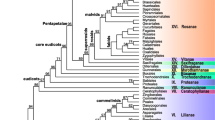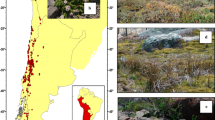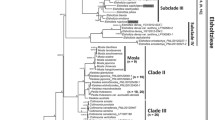Abstract
Molecular systematics has revolutionized our understanding of the evolution of the Proteaceae. Phylogenetic relationships have been reconstructed down to generic level and below from alignments of chloroplast and nuclear DNA sequences. These trees have enabled the monophyly of all subfamilies, tribes, and subtribes to be rigorously tested and the construction of a new classification of the family at these ranks. Molecular data have also played a major part in testing the monophyly of genera and infrageneric taxa, some of which have been recircumscribed as a result. Molecular trees and chronograms have been used to test numerous previously postulated biogeographic and evolutionary hypotheses, some of which have been modified or abandoned as a result. Hypotheses that have been supported by molecular phylogenetic trees and chronograms include the following: that the proteaceous pattern of repeated disjunct distributions across the southern hemisphere is partly the result of long-distance dispersal; that high proteaceous diversity in south-western Australia and the Cape Floristic Region of South Africa is due to high diversification rates in some clades but is not an evolutionary response to Mediterranean climates; that the sclerophyllous leaves of many shrubby members of the family are not adaptations to dry environments but for protecting mesophyll in brightly illuminated habitats; that deeply encrypted foliar stomata are adaptations for minimizing water loss in dry environments; and that Protea originated in the Cape Floristic Region of South Africa and that one of its subclades has greatly expanded its distribution into tropical savannas. Reconstructing phylogeny down to species level is now the main goal of molecular systematists of the Proteaceae. The biggest challenge in achieving this task will be resolving species trees from numerous gene trees in complexes of closely related species.
Access this chapter
Tax calculation will be finalised at checkout
Purchases are for personal use only
Similar content being viewed by others
References
Brown R (1810) On the Proteaceae of Jussieu. Trans Linn Soc London 10:15–226
Hooker JD (1853) The botany of the Antarctic Voyage of H.M. Discovery Ships Erebus and Terror, in the years 1839–1843. II Flora Novae-Zelandiae. Lovell Reeve, London
Hooker JD (1859) The botany of the Antarctic Voyage of H.M. Discovery Ships Erebus and Terror, in the years 1839–1843. III Flora Tasmaniae. Reeve, London
Johnson LAS, Briggs BG (1975) On the Proteaceae—the evolution and classification of a southern family. Bot J Linn Soc 70:83–182
Martin PG, Dowd JM (1984) The study of plant phylogeny using amino acid sequences of ribulose-1,5-bisphosphate carboxylase. IV Proteaceae and Fagaceae and the rate of evolution of the small subunit. Aust J Bot 32: 291–299
Martin PG, Dowd JM (1988) A molecular evolutionary clock for angiosperms. Taxon 37:364–377
Chase MW, Soltis DE, Olmstead RG, Morgan D, Les DH, Mishler BD, Duvall MR, Price RA, Hills HG, Qiu YL, Kron KA, Rettig JH, Conti E, Palmer JD, Manhart JR, Sytsma KJ, Michael HJ, Kress WJ, Karol KG, Clark WD, Hedren M, Gaut BS, Jansen RK, Kim KJ, Wimpee CF, Smith JF, Furnier GR, Strauss SH, Xiang QY, Plunkett GM, Soltis PS, Swensen SM, Williams SE, Gadek PA, Quinn CJ, Eguiarte LE, Golenberg E, Learn GH, Graham SW, Barrett SCH, Dayanandan S, Albert VA (1993) Phylogenetics of seed plants: an analysis of nucleotide sequences from the plastid gene rbcL. Ann Missouri Bot Gard 80:528–580
Drinnan AN, Crane PR, Hoot SB (1994) Patterns of floral evolution in the early diversification of non-magnoliid dicotyledons (eudicots). Pl Syst Evol 8(Suppl):93–122
Soltis DE, Soltis PS, Chase MW, Mort ME, Albach DC, Zanis M, Savolainen V, Hahn WH, Hoot SB, Fay MF, Axtell M, Swensen SM, Prince LM, Kress WJ, Nixon KC, Farris JS (2000) Angiosperm phylogeny inferred from 18S rDNA, rbcL, and atpB sequences. Bot J Linn Soc 133:381–461
Soltis DE, Smith SA, Cellinese N, Wurdack KJ, Tank DC, Brockington SF, Refulio-Rodriguez NF, Walker JB, Moore MJ, Carlsward BS, Bell CD, Latvis M, Crawley S, Black C, Diouf D, Xi Z, Rushworth CA, Gitzendanner MA, Sytsma KJ, Qiu Y-L, Hilu KW, Davis CD, Sanderson MJ, Beaman RS, Olmstead RG, Judd WS, Donoghue MJ, Soltis PS (2011) Angiosperm phylogeny: 17 genes, 640 taxa. Am J Bot 98:704–730
Carpenter RJ, Hill RS, Jordan GJ (2005) Leaf cuticular morphology links Platanaceae and Proteaceae. Int J Plant Sci 166:843–855
Hoot SB, Douglas AW (1998) Phylogeny of the Proteaceae based on atpB and atpB–rbcL intergenic spacer region sequences. Aust Syst Bot 11
Weston PH, Barker NP (2006) A new suprageneric classification of the Proteaceae, with an annotated checklist of genera. Telopea 11:314–344
Barker NP, Weston PH, Rourke JP, Reeves G (2002) The relationships of the southern African Proteaceae as elucidated by internal transcribed spacer (ITS) DNA sequence data. Kew Bull 57:867–883
Barker NP, Weston PH, Rutschmann F, Sauquet H (2007) Molecular dating of the “Gondwanan” plant family Proteaceae is only partially congruent with the timing of Gondwanan break-up. J Biogeogr 34: 2012–2027
Weston PH, Crisp MD (1996) Trans-Pacific biogeographic patterns in the Proteaceae. In: Keast A, Miller SE (eds) The origin and evolution of Pacific Island Biotas, New Guinea to Eastern Polynesia: patterns and processes. SPB Academic Publishing, Amsterdam, pp 215–232
Mast AR, Willis CL, Jones EH, Downs KM, Weston PH (2008) A smaller Macadamia from a more vagile tribe: inference of phylogenetic relationships and divergence times in Macadamia and relatives (tribe Macadamieae; Proteaceae). Am J Bot 95:843–870
Sauquet H, Weston PH, Anderson CL, Barker NP, Cantrill DJ, Mast AR, Savolainen V (2009) Contrasted patterns of hyperdiversification in Mediterranean hotspots. Proc Natl Acad Sci U S A 106:221–225
Sauquet H, Weston PH, Barker NP, Anderson CL, Cantrill DJ, Savolainen V (2009) Using fossils and molecular data to reveal the origins of the Cape proteas (subfamily Proteoideae). Mol Phylogenet Evol 51:31–43
Jordan GJ, Dillon RA, Weston PH (2005) Solar radiation as a factor in the evolution of scleromorphic leaf anatomy in Proteaceae. Am J Bot 92:789–796
Jordan GJ, Weston PH, Carpenter RJ, Dillon RA, Brodribb TJ (2008) The evolutionary relations of sunken, covered, and encrypted stomata to dry habitats in Proteaceae. Am J Bot 95:521–530
Crisp MD, Arroyo MTK, Cook LG, Gandolfo MA, Jordan GJ, McGlone MS, Weston PH, Westoby M, Wilf P, Linder HP (2009) Phylogenetic habitat conservatism on a global scale. Nature (Lond) 458:754–756
Mast AR (1998) Molecular systematics of subtribe Banksiinae (Banksia and Dryandra; Proteaceae) based on cpDNA and nrDNA sequence data: implications for taxonomy and biogeography. Aust Syst Bot 11:321–342
Mast AR, Givnish TJ (2002) Historical biogeography and the origin of stomatal distributions in Banksia and Dryandra (Proteaceae) based on their cpDNA phylogeny. Am J Bot 89:1311–1323
Mast AR, Jones EH, Havery SP (2005) An assessment of old and new DNA sequence evidence for the paraphyly of Banksia with respect to Dryandra (Proteaceae). Aust Syst Bot 18:75–88
George AS (1981) The genus Banksia L.f. (Proteaceae). Nuytsia 3:239–473
George AS (1999) Banksia. In: Wilson A (ed) Flora of Australia, vol 17B, Proteaceae 3 Hakea to Dryandra. ABRS/CSIRO, Melbourne, pp 175–251
Thiele K, Ladiges PY (1996) A cladistic analysis of Banksia (Proteaceae). Aust Syst Bot 9:661–733
Mast AR, Thiele K (2007) The transfer of Dryandra R.Br. to Banksia L.f. (Proteaceae). Aust Syst Bot 20:63–71
Cavanagh T (2007) So Dryandra becomes Banksia—what’s all the fuss about? Aust Plants (http://anpsa.org.au/APOL2007/aug07-1.html)
George AS (2008) You don’t have to call Dryandra Banksia. Aust Plants (http://anpsa.org.au/APOL2008/sep08-2.html)
Crisp MD, Cook LG (2007) A congruent molecular signature of vicariance across multiple plant lineages. Mol Phylogenet Evol 43:1106–1117
He T, Lamont BB, Downes KS (2011) Banksia born to burn. New Phytol 191:184–196
Barker NP, Vanderpoorten A, Morton CM, Rourke JP (2004) Phylogeny, biogeography, and the evolution of life-history traits in Leucadendron (Proteaceae). Mol Phylogenet Evol 33:845–860
Barraclough TG, Reeves G (2005) The causes of speciation in flowering plant lineages: species-level DNA trees in the African genus Protea. In: Bakker FT, Chatrou L, Gravendeel B, Pelser P (eds) Plant species-level systematics: patterns, processes and new applications. Koeltz, Königstein, pp 31–46
Valente LM, Reeves G, Schnitzler J, Mason IP, Fay MF, Rebelo TG, Chase MW, Barraclough TG (2009) Diversification of the African genus Protea (Proteaceae) in the Cape biodiversity hotspot and beyond: equal rates in different biomes. Evolution 64:745–760
Mast AR, Milton EF, Jones EH, Barker RM, Barker WR, Weston PH (2012) Time-calibrated phylogeny of the woody Australian genus Hakea (Proteaceae) supports multiple origins of insect-pollination among bird-pollinated ancestors. Am J Bot 99:472–487
Williams IJM (1972) A revision of the genus Leucadendron (Proteaceae). Contrib Bol Herb 3:1–425
Rebelo AG (2001) A field guide to the proteas of southern Africa. Fernwood, South Africa
Barker WR, Barker RM, Haegi L (1999) Introduction to Hakea. In: Wilson A (ed) Flora of Australia, vol 17B, Proteaceae 3, Hakea to Dryandra. ABRS/CSIRO, Canberra, Australia, pp 1–30
Hanley ME, Lamont BB, Armbruster WS (2009) Pollination and plant defence traits co-vary in Western Australian Hakeas. New Phytol 182:251–260
Byrne M, Macdonald B, Coates D (1999) Divergence in the chloroplast genome and nuclear rDNA of the rare Western Australian plant Lambertia orbifolia Gardner (Proteaceae). Mol Ecol 8:1789–1796
Krauss SL (2000) Patterns of mating in Persoonia mollis (Proteaceae) revealed by an analysis of paternity using AFLP: implications for conservation. Aust J Bot 48:349–356
Rymer PD, Ayre DJ (2006) Does genetic variation and gene flow vary with rarity in obligate seeding Persoonia species (Proteaceae)? Conserv Genet 7:919–930
Holmes GD, James EA, Hoffmann AA (2008) Divergent levels of genetic variation and ploidy among small populations of the rare shrub, Grevillea repens. Conserv Genet 10:827–837. doi:10.1007/S10592-008-9643-9
Coates DJ, Sokolowski RES (1992) The mating system and patterns of genetic variation in Banksia cuneata A.S.George (Proteaceae). Heredity 69:11–20
Krauss SL (1994) Restricted gene flow within the morphologically complex species Persoonia mollis (Proteaceae): contrasting evidence from the mating system and pollen dispersal. Heredity 73:142–154. doi:10.1038/hdy.1994.113
Coates DJ, Hamley VL (1999) Genetic divergence and the mating system in the endangered and geographically restricted species, Lambertia orbifolia Gardner (Proteaceae). Heredity 83:418–427
Millar MA, Byrne M, Coates DJ (2010) The maintenance of disparate levels of clonality, genetic diversity and genetic differentiation in disjunct subspecies of the rare Banksia ionthocarpa. Mol Ecol 19:4217–4227
Llorens TM, Byrne M, Yates CJ, Nistelberger HM, Coates DJ (2012) Evaluating the influence of different aspects of habitat fragmentation on mating patterns and pollen dispersal in the bird-pollinated Banksia sphaerocarpa var. caesia. Mol Ecol 21:314–328
Lamont BB, He T, Enright NJ, Krauss SL, Miller BP (2003) Anthropogenic disturbance promotes hybridization between Banksia species by altering their biology. J Evol Biol 16:551–557
Krauss SL (1997) Low genetic diversity in Persoonia mollis (Proteaceae), a fire-sensitive shrub occurring in a fire-prone habitat. Heredity 78:41–49. doi:10.1038/hdy.1997.5
Krauss SL (1998) A phylogeographic analysis of allozyme variation amongst populations of Persoonia mollis (Proteaceae). Aust J Bot 46:571–582
Rossetto M, Thurlby KAG, Offord CA, Allen CB, Weston PH (2011) The impact of distance and a shifting temperature gradient on genetic connectivity across a heterogeneous landscape. BMC Evol Biol 11:126
Prunier R, Holsinger KE (2010) Was it an explosion? Using population genetics to explore the dynamics of a recent radiation within Protea (Proteaceae L.). Mol Ecol 19:3968–3980
Felsenstein J (1981) Evolutionary trees from gene frequencies and quantitative characters: finding maximum likelihood estimates. Evolution 35:1229–1242
Felsenstein J (2005) PHYLIP (Phylogeny Inference Package) version 3.6. Distributed by the author, Department of Genome Sciences, University of Washington, Seattle.
Pritchard JK, Stephens M, Donnelly P (2000) Inference of population structure using multilocus genotype data. Genetics 155:945–959
Anderson EC, Thompson EA (2002) A model-based method for identifying species hybrids using multilocus genetic data. Genetics 160:1217–1229
McPherson H, van der Merwe M, Delaney SK, Edwards MA, Henry RJ, McIntosh E, Rymer PD, Milner ML, Siow J, Rossetto M (2013) Capturing chloroplast variation for molecular ecology studies: a simple Next Generation Sequencing approach applied to a rainforest tree. Mol Ecol 13:8
Knowles LL (2009) Estimating species trees: methods of phylogenetic analysis when there is incongruence across genes. Syst Biol 58:463–467
Leaché AD, Rannala B (2011) The accuracy of species tree estimation under simulation: a comparison of methods. Syst Biol 60: 126–137
Cranston KA, Hurwitz B, Ware D, Stein L, Wing RA (2009) Species trees from highly incongruent gene trees in rice. Syst Biol 58: 489–500
Acknowledgements
I am grateful to Barbara Briggs and Maurizio Rossetto for their critical comments on an earlier draft of the manuscript and to Karen Rinkel who kindly drafted Fig. 1.
Author information
Authors and Affiliations
Editor information
Editors and Affiliations
Rights and permissions
Copyright information
© 2014 Springer New York
About this protocol
Cite this protocol
Weston, P.H. (2014). What Has Molecular Systematics Contributed to Our Knowledge of the Plant Family Proteaceae?. In: Besse, P. (eds) Molecular Plant Taxonomy. Methods in Molecular Biology, vol 1115. Humana Press, Totowa, NJ. https://doi.org/10.1007/978-1-62703-767-9_18
Download citation
DOI: https://doi.org/10.1007/978-1-62703-767-9_18
Published:
Publisher Name: Humana Press, Totowa, NJ
Print ISBN: 978-1-62703-766-2
Online ISBN: 978-1-62703-767-9
eBook Packages: Springer Protocols




